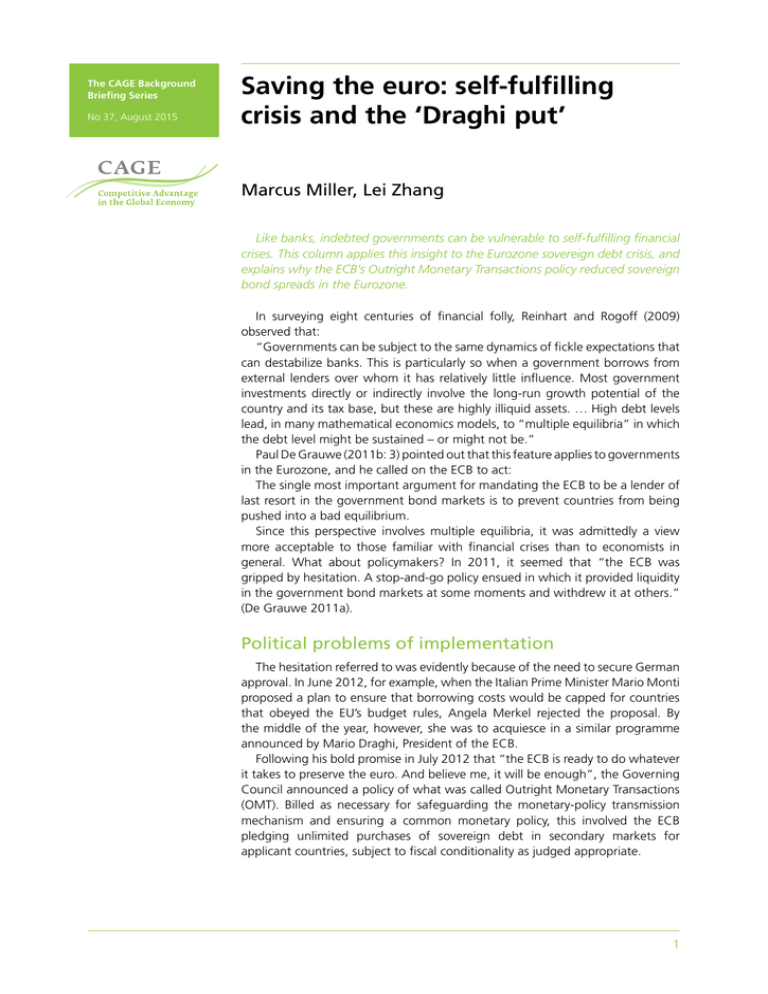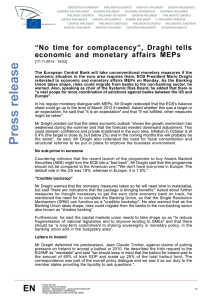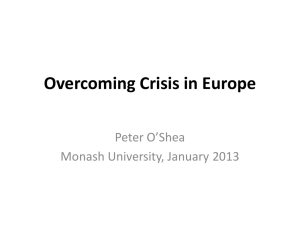Saving the euro: self-fulfilling crisis and the ‘Draghi put’
advertisement

The CAGE Background Briefing Series No 37, August 2015 Saving the euro: self-fulfilling crisis and the ‘Draghi put’ Marcus Miller, Lei Zhang Like banks, indebted governments can be vulnerable to self-fulfilling financial crises. This column applies this insight to the Eurozone sovereign debt crisis, and explains why the ECB’s Outright Monetary Transactions policy reduced sovereign bond spreads in the Eurozone. In surveying eight centuries of financial folly, Reinhart and Rogoff (2009) observed that: “Governments can be subject to the same dynamics of fickle expectations that can destabilize banks. This is particularly so when a government borrows from external lenders over whom it has relatively little influence. Most government investments directly or indirectly involve the long-run growth potential of the country and its tax base, but these are highly illiquid assets. … High debt levels lead, in many mathematical economics models, to “multiple equilibria” in which the debt level might be sustained – or might not be.” Paul De Grauwe (2011b: 3) pointed out that this feature applies to governments in the Eurozone, and he called on the ECB to act: The single most important argument for mandating the ECB to be a lender of last resort in the government bond markets is to prevent countries from being pushed into a bad equilibrium. Since this perspective involves multiple equilibria, it was admittedly a view more acceptable to those familiar with financial crises than to economists in general. What about policymakers? In 2011, it seemed that “the ECB was gripped by hesitation. A stop-and-go policy ensued in which it provided liquidity in the government bond markets at some moments and withdrew it at others.” (De Grauwe 2011a). Political problems of implementation The hesitation referred to was evidently because of the need to secure German approval. In June 2012, for example, when the Italian Prime Minister Mario Monti proposed a plan to ensure that borrowing costs would be capped for countries that obeyed the EU’s budget rules, Angela Merkel rejected the proposal. By the middle of the year, however, she was to acquiesce in a similar programme announced by Mario Draghi, President of the ECB. Following his bold promise in July 2012 that “the ECB is ready to do whatever it takes to preserve the euro. And believe me, it will be enough”, the Governing Council announced a policy of what was called Outright Monetary Transactions (OMT). Billed as necessary for safeguarding the monetary-policy transmission mechanism and ensuring a common monetary policy, this involved the ECB pledging unlimited purchases of sovereign debt in secondary markets for applicant countries, subject to fiscal conditionality as judged appropriate. 1 Saving the euro: self-fulfilling crisis and the ‘Draghi put’ As Peter Spiegel points out, “Mr Draghi’s programme was unlikely to have quelled markets without Ms Merkel’s acquiescence, which was given despite the public objections of the powerful German Bundesbank1 … Ms Merkel’s willingness to back OMT was a reflection of how deep the crisis had grown that summer.” Calvo’s analysis “If it’s a self-fulfilling crisis, it’s stoppable by an act of belief.” This is the sentiment explored in the classic paper by Calvo (1988), in which market expectations of default on sovereign debt can lead to a self-fulfilling crisis. We use this here to show how OMT can avert such a crisis. Plotting market expectations of partial default ( e ) and the government’s policy response ( ) against the market rate of interest is a nice way to visualise the problem, as Corsetti and Dedola (2013) point out. As the gross market interest rate R rises above RA, the safe rate on German bonds, it acts both as a measure of market expectations and a possible trigger of government action, as shown in Figure 1. Figure 1. Self-fulfilling partial default Partial Default (%) DRAGHI PUT Policy Response e B B Market Expectation A RA RC RB R Market Rate Expected default Market expectations of partial default can be deduced from the arbitrage condition that default-adjusted rates match the safe rate, RA.2 This is shown by the dashed line increasing to the right from point A. Policy response For Calvo, the rate of partial default – if any – chosen by the sovereign debtor follows from the ‘budget constraint’ that the primary surplus covers the service cost of debt that is being honoured in full plus the cost associated with partial default on what remains.3 As Figure 1 shows, for market rates that lie just above the safe rate, RA, the government can honour its debt in full, so market fears will not be realised. For market rates above the ‘critical’ rate, RC, however, the government will opt for partial default, and this at a pace that increases with market expectations. 2 Saving the euro: self-fulfilling crisis and the ‘Draghi put’ Multiple equilibria There are, evidently, two cases where expectations turn out to be justified by outcomes. •An equilibrium at A where no default is expected and the interest rate is the safe rate RA; and • A self-fulfilling ‘bad’ equilibrium, B, where the interest rate is RB. What about stability? Assume, for example, that default expectations were to adjust to policy choice so the default rate expected by the market moves towards the current stance of policy, subject to random shocks (such as when Greece defaulted on its sovereign debt). Then, in the absence of shocks, e will be falling for interest rates below RB, and the interest rate will converge to the safe rate RA ; but conversely, there will be ever-increasing divergence for rates above RB (as indicated by the arrows either side of RB in Figure 1). This suggests that equilibrium at point A is stable while B is unstable, with interest rates between RA and RB lying in a region of stability (subject, of course, to the absence of shocks). ECB policy intervention: The ‘Draghi put’ The policy announced by the ECB in 2012 was described as one of Outright Monetary Transactions (OMT), as it is supposed to improve the monetary-policy transmission mechanism via increased harmonisation of interest rates across Europe. It could better be described as the issue of a put on sovereign bonds – a ‘Draghi put’ – with moral hazard aspects, in principle, covered by the fiscal conditionality.4 If successful, such a put – where the ECB establishes a floor price for the debt of sovereigns who are solvent but face a crisis of liquidity – could rule out the default equilibrium. As a floor on the price implies an interest ceiling, such an intervention that keeps market interest rates at manageable levels (strictly R < RB) should in principle avoid triggering partial default and help to stabilise market expectations. This is illustrated in Figure 1, with a put that limits interest rates to lie in the region of stability at or below the critical rate RC. The announcement of this facility had a marked effect on prices of sovereign debt, with a substantial reduction in yields for Spain and Italy – see Figure 2. Figure 2. Effects of OMT: benchmark bond yields in 2012 6 September – ECB announces Outright Monetary Transaction programme 7.5% 7.0% Spanish bonds 6.5% 6.0% 5.5% Italian bonds 5.0% 4.5% Jan Feb Mar Apr Jun Jul Jul Aug Sep Oct Source: Thomson Reuters. 3 Saving the euro: self-fulfilling crisis and the ‘Draghi put’ To date, no sovereign has requested intervention by the ECB under OMT, and ten-year benchmark bond spreads in both countries have fallen to below 200 basis points (bps) – see Figure 3. Figure 3. Spreads against the German bund during the sovereign debt crisis 700 600 500 Spain 400 300 200 100 Italy 11 12 13 14 Source: Thomson Reuters DataStream, Reuters Graphic/Scott Barber 11 June 2014. Conclusion At the time, seasoned observers such as Martin Wolf doubted whether the ‘Draghi put’ would succeed. But, as he now acknowledges, “Mr. Draghi saved the day in July 2012”. Given the sorry state of European economies, however, he also calls for more active monetary policy: “it is the ECB’s job to hit its inflation target and strengthen credit markets” (Wolf 2014). Why not add debt restructuring (conditional on reform) to the policy mix, as for over-leveraged companies that file for Chapter 11? This might, as we argue in Miller and Zhang (2012), help peripheral Eurozone countries avoid a Prisoner’s Dilemma, where fiscal austerity is used as a badge of financial responsibility. References Calvo, G (1988), “Servicing the Public Debt: The Role of Expectations”, The American Economic Review, 78(4): 647–661. Corsetti, G and L Dedola (2013), “The Mystery of the Printing Press: Selffulfilling debt crises and monetary sovereignty”, CEPR Discussion Paper 9358. De Grauwe, P (2011a), “The European Central Bank as a lender of last resort”, VoxEU.org, 18 August. De Grauwe, P (2011b), “The European Central Bank: Lender of Last Resort in the Government Bond Market?”, CESifo Working Paper 3569. Dornbusch, R and M Draghi (1990), Public Debt Management: Theory and History, Cambridge: Cambridge University Press. Draghi, M (2012), Speech, 26 July 26. http://www.ecb.europa.eu/press/key/ date/2012/html/sp120726.en.html Miller, M (2012), “How OMT came to be”, 12 October. Miller, M and L Zhang (2012), “Saving the Euro: Self-fulfilling Crisis and the Draghi Put”, CEPR Discussion Paper 9976. 4 Saving the euro: self-fulfilling crisis and the ‘Draghi put’ Reinhart, C and K Rogoff (2009), This Time is Different: Eight Centuries of Financial Folly, Princeton. Spiegel, P (2014), “How the euro was saved, part 3”, Financial Times, 16 May: 9. Wolf, M (2014), “Time for Draghi to open the sluice”, Financial Times, 14 May: 13. Footnotes 1 With two members associated with the Bundesbank resigning from the ECB over the issue. 2 Formally, R(1 — e )= RA. bR, where b is the stock of debt, 3 Formally, t — g=(1 — )b(R-1) + other – unit costs of defaulting, and t — g is the primary surplus. indicates the – legal and 4 A mythical account of the origins of OMT was provided by one of us to celebrate the Italian translation of Dornbusch and Draghi’s volume on Public Debt Management (Miller, 2012). 5 About CAGE Established in January 2010, CAGE is a research centre in the Department of Economics at the University of Warwick. Funded by the Economic and Social Research Council (ESRC), CAGE is carrying out a five year programme of innovative research. The Centre’s research programme is focused on how countries succeed in achieving key economic objectives, such as improving living standards, raising productivity and maintaining international competitiveness, which are central to the economic well-being of their citizens. CAGE’s research analyses the reasons for economic outcomes both in developed economies such as the UK and emerging economies such as China and India. The Centre aims to develop a better understanding of how to promote institutions and policies that are conducive to successful economic performance and endeavours to draw lessons for policy-makers from economic history as well as the contemporary world. This piece first appeared on Voxeu on 26 June 2014 http://www.voxeu.org/article/self-fulfilling-eurozone-debt-crises-and-draghi-put VOX Research-based policy analysis and commentary from leading economists © 2015 The University of Warwick Published by the Centre for Competitive Advantage in the Global Economy Department of Economics, University of Warwick, Coventry CV4 7AL www.warwick.ac.uk/cage Artwork by Mustard, www.mustardhot.com

